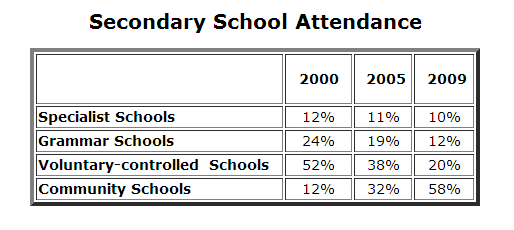The table illustrates the comparison of additional school attendance from 2000 to 2009. It is evident that community school attendance experienced an increase , while the third of school forms showed decrease over the following of the period.
To begin, in 2000, the percentage of voluntary-controlled school attendance were largest at 52% among others and the second was grammar school attendance at 24%, whereas special schools and community school attendance had similar figures of proportion less than a second. Following this, voluntary-controlled schools were popular subjects at 38% and there was quarrel by 6% of community schools in 2005. A minority subject obtained in specialist schools at 11%, which was followed by grammar schools less than a month.
In the end of period, 2009, a significant proportion were taken by community schools attendance at 58% and all of the subject schools were very low amounts for attendance percentage under 15%, the only exception to voluntary-controlled schools at under a quarter.
To begin, in 2000, the percentage of voluntary-controlled school attendance were largest at 52% among others and the second was grammar school attendance at 24%, whereas special schools and community school attendance had similar figures of proportion less than a second. Following this, voluntary-controlled schools were popular subjects at 38% and there was quarrel by 6% of community schools in 2005. A minority subject obtained in specialist schools at 11%, which was followed by grammar schools less than a month.
In the end of period, 2009, a significant proportion were taken by community schools attendance at 58% and all of the subject schools were very low amounts for attendance percentage under 15%, the only exception to voluntary-controlled schools at under a quarter.

ES8.png
